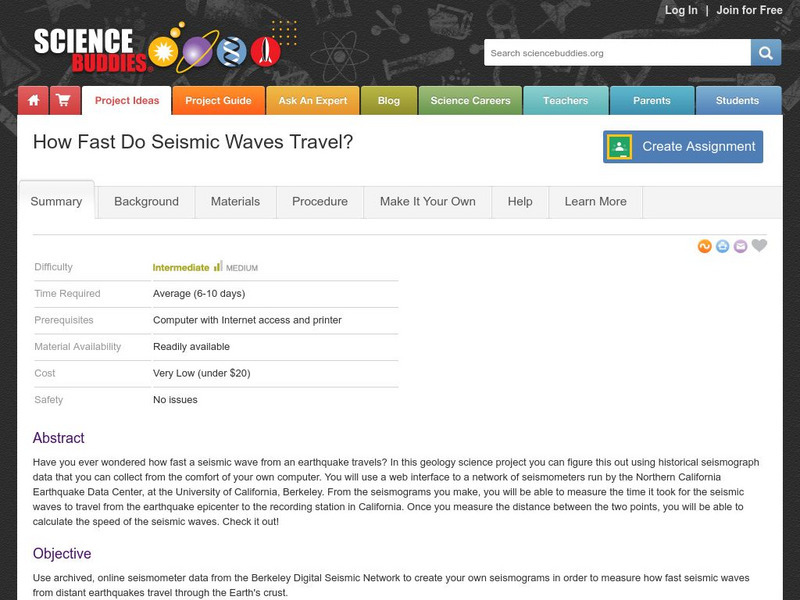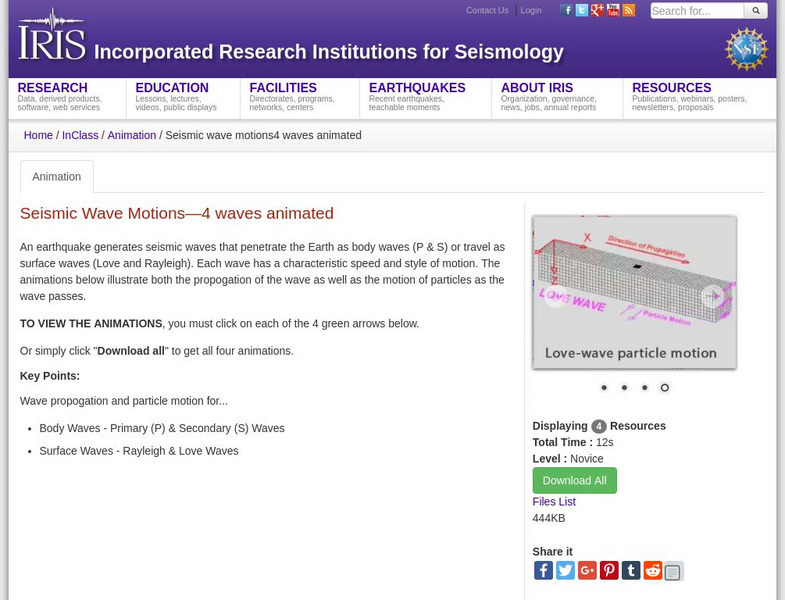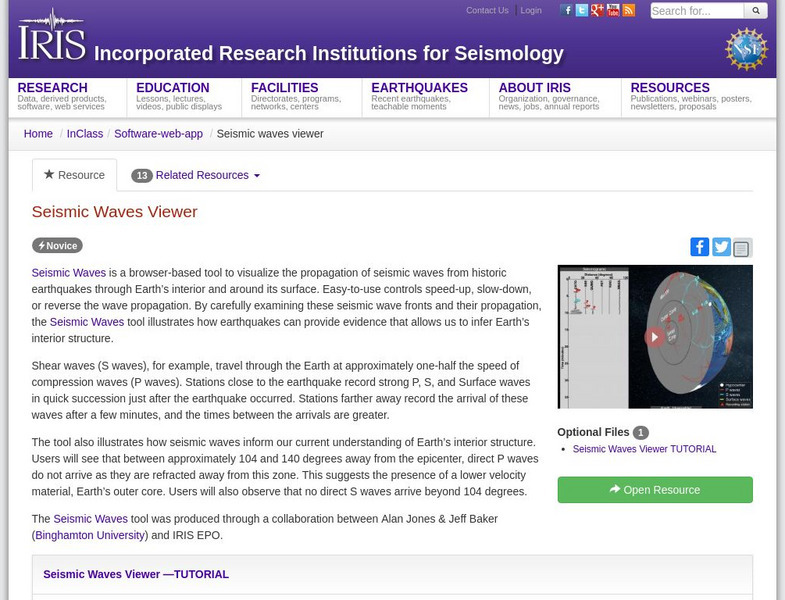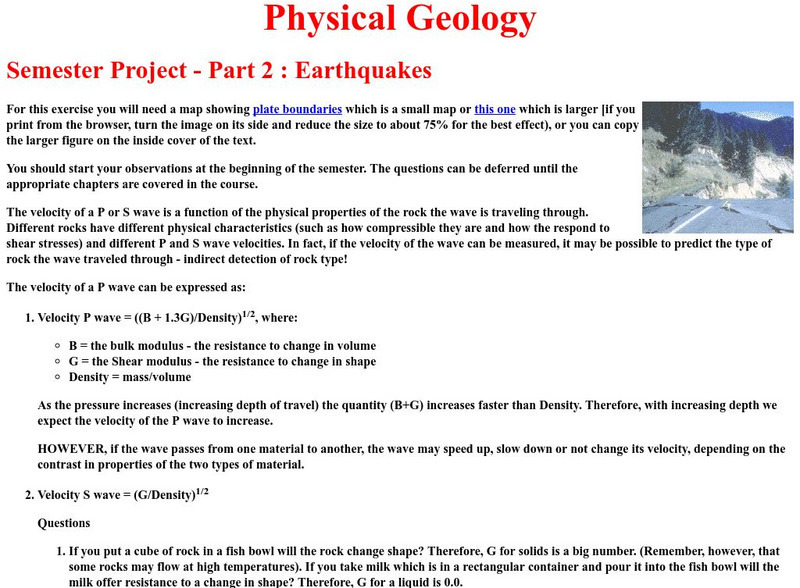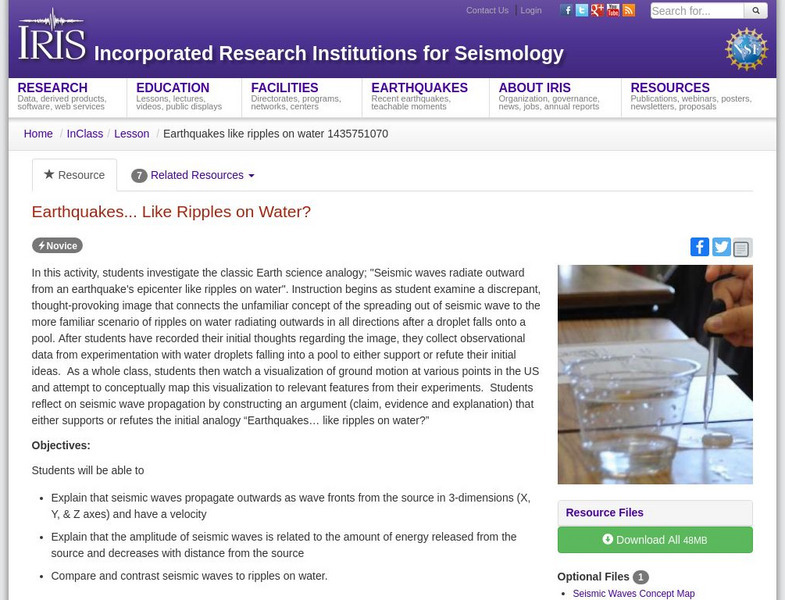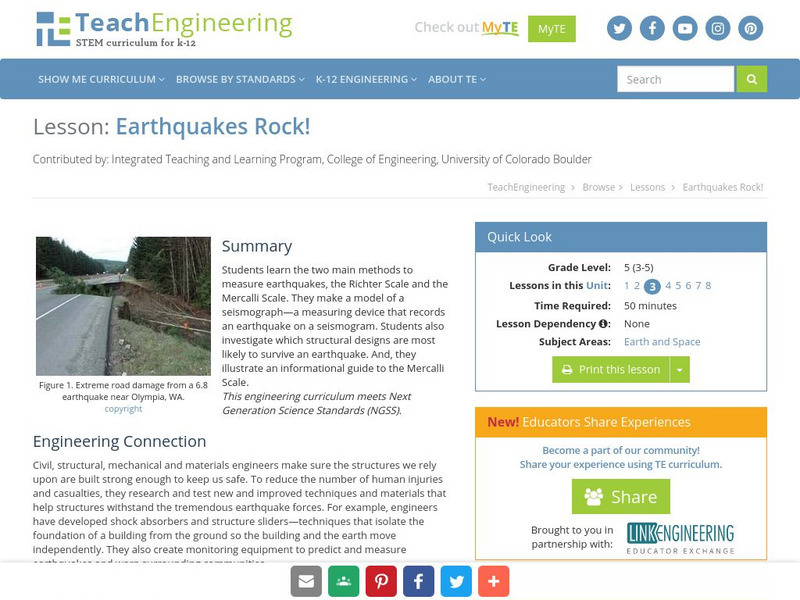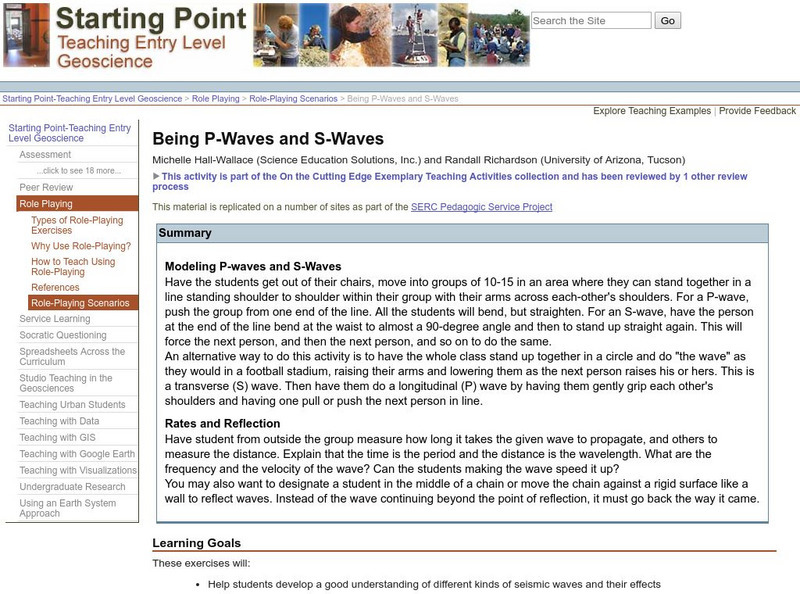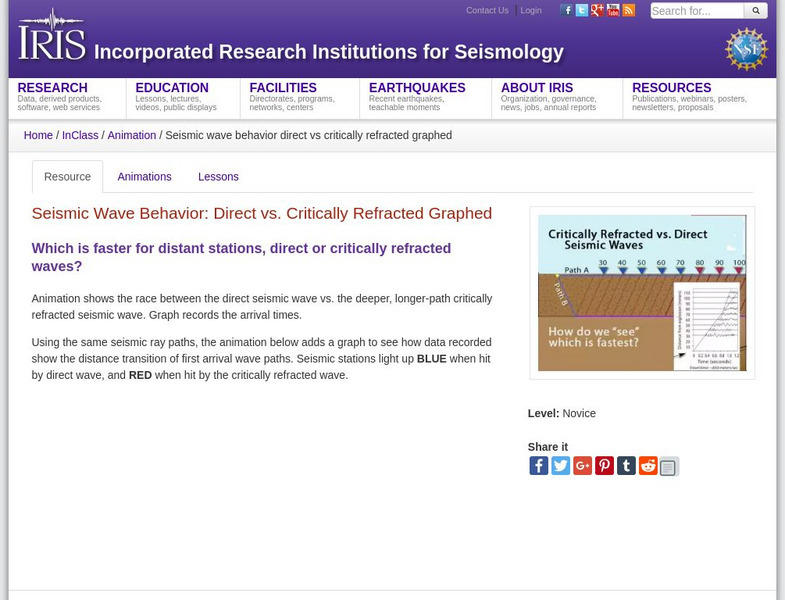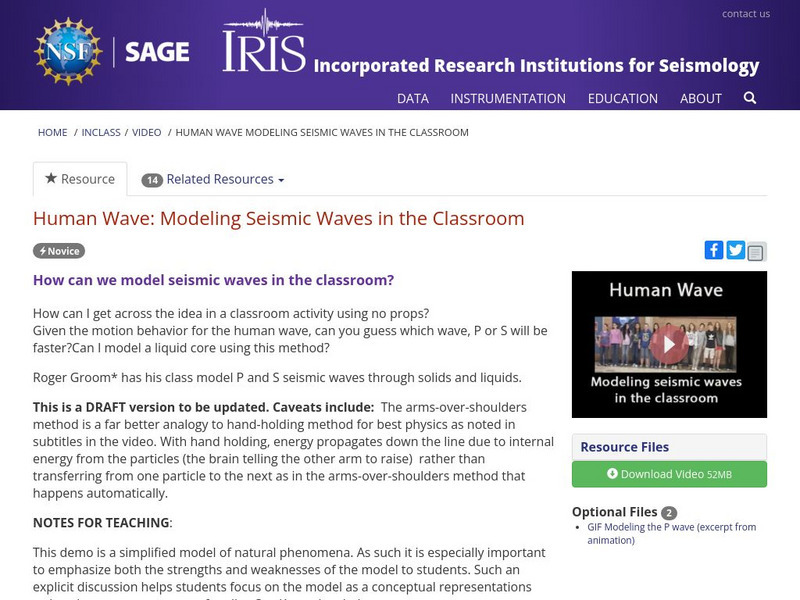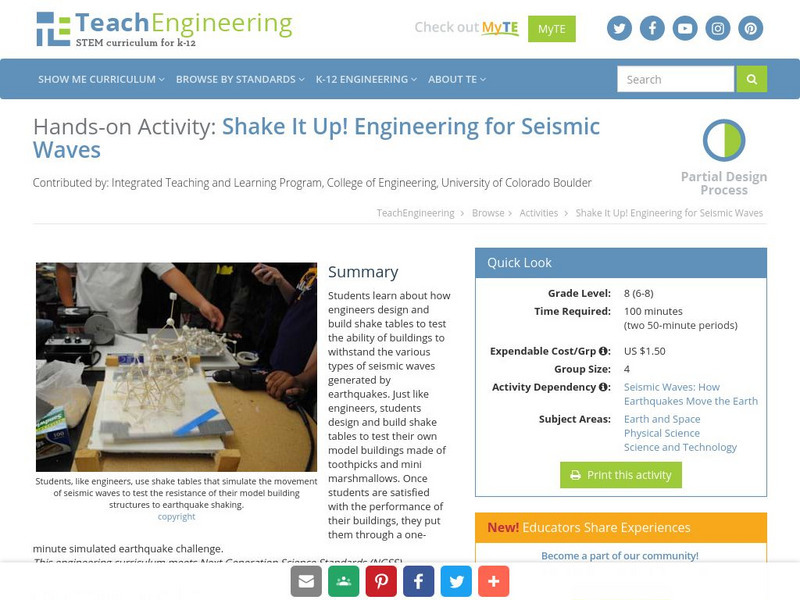Hi, what do you want to do?
PBS
Pbs News Hour Extra: You Don't Need a Seismograph to Study Earthquakes
Three part lesson will provide students with information about earthquakes and how to predict them using various Web sites. Activities include historical background on major earthquakes, investigating mechanical waves, and simulating...
Science Buddies
Science Buddies: How Fast Do Seismic Waves Travel?
Here's a geology project that uses historical seismograph data that you can collect from the comfort of your own computer. You'll use a web interface to a network of seismometers run by the Northern California Earthquake Data Center, at...
Science Buddies
Science Buddies: Set Your Table for a Sweet and Sticky Earthquake Shake
Earthquakes can have different affects depending on their location. This week long exercise asks you to build a model house and a special table to shake it on, and see how different soil types can amplify shaking.
Other
University of Wisconsin Green Bay: Faults and Earthquakes
This site is primarily set up as an outline and is loaded with graphs, maps, and images. It covers a variety of earthquake-related topics, such as what causes earthquakes, fault lines and structures, seismology, a historical look at...
Incorporated Research Institutions for Seismology
Iris: Seismic Wave Motions
Four animations showing the movements of surface waves and body waves that are created by earthquakes. Includes P, S, Rayleigh, and Love waves.
CK-12 Foundation
Ck 12: Plix: Earthquake: Earth's Interior
[Free Registration/Login Required] A look inside the Earth to see what happens as an earthquake propagates through it. Also on the site is a short quiz based on seismic waves.
Incorporated Research Institutions for Seismology
Iris: Seismic Waves Viewer
Visualize the propagation of seismic waves from historic earthquakes through Earth's interior and around its surface.
CK-12 Foundation
Ck 12: Plix: Alaskan Earthquake: Seismic Waves
[Free Registration/Login Required] A site that diagrams what happens if a major earthquake occurs over Alaska. A short quiz over the topic is also included.
Michigan Technological University
Michigan Tech University: Where Do Earthquakes Happen?
An informative site that explains how and where earthquakes occur and the different types of faults. Contains maps and charts of fault lines, plate edges, and the continental plates. There are other links within the site of related...
Other
Matter Project: Seismic Waves
Seismic waves are studied to better understand the ground beneath us, the layers of Earth and points of interest for earthquakes. Better understand the types of waves, what substances they may travel through and how, and gain a clearer...
University of Houston
University of Houston: Earthquakes
This exercise will help students understand the plate boundaries of earthquakes.
Incorporated Research Institutions for Seismology
Iris: Earthquakes, Like Ripples on Water?
In this activity, students investigate the classic Earth science analogy, "Seismic waves radiate outward from an earthquake's epicenter like ripples on water."
Incorporated Research Institutions for Seismology
Iris: Walk Run: Locating an Earthquake Using Triangulation
Roll over the seismic stations to see earthquake epicenters triangulated. Touch buttons to watch movies of seismic waves.
TeachEngineering
Teach Engineering: Earthquakes Rock!
Students learn the two main methods to measure earthquakes, the Richter Scale and the Mercalli Scale. They make a model of a seismograph - a measuring device that records an earthquake on a seismogram. Students also investigate which...
Incorporated Research Institutions for Seismology
Iris: How Are Earthquakes Located?
This illustrated fact sheet shows how S and P waves each travel at varying speeds and therefore arrive at seismic stations at different times.
University at Buffalo
University at Buffalo: Mceer: Earthquake Engineering to Extreme Events
Information from the Multidisciplinary Center for Earthquake Engineering Research guided toward enhancing the ability of communities to survive and rebuild after an earthquake. Includes current news and conferences, and information about...
Science Education Resource Center at Carleton College
Serc: Being P Waves and S Waves
In this lesson learners develop a good understanding of different kinds of seismic waves and their effects.
Incorporated Research Institutions for Seismology
Iris: Seismic Wave Behavior: Direct vs. Critically Refracted Graphed
Examine the behavior of seismic waves. This graph illustrates direct and critically refracted waves.
University of California
Earthguide: Mystery Detectives: Mystery Epicenter: Earthquake
Students analyze seismograms to locate mystery earthquake epicenters as they produce a news story about a major local earthquake to complete their mission.
Incorporated Research Institutions for Seismology
Iris: Human Wave: Modeling Seismic Waves in the Classroom
A demo of how can we model seismic waves in the classroom. [8:27]
TeachEngineering
Teach Engineering: Shake It Up! Engineering for Seismic Waves
Students learn about how engineers design and build shake tables to test the ability of buildings to withstand the various types of seismic waves generated by earthquakes. Just like engineers, students design and build shake tables to...
Oswego City School District
Regents Exam Prep Center: Earth's Interior
A basic overview of the earth's mantle, crust, inner core, and outer core. Also discusses how earthquake waves travel through the Earth.
Exploratorium
Exploratorium: The Faultline/seismic Slinky
A lesson plan for investigating longitudinal waves by use of a Slinky toy. Directions, questions, and applications to seismic waves are provided.
US Geological Survey
U.s. Geological Survey: Learning About Earthquakes Coloring Pages
Coloring pictures of seismic waves, earthquake safety and hazard maps. [PDF] Links to other handy tools, including trivia, stories, games and fun projects.






